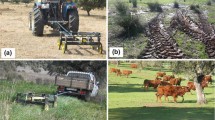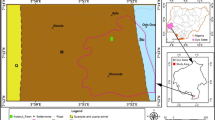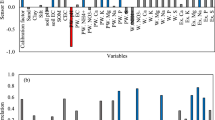Abstract
On-the-go EC sensor is a useful tool in mapping the apparent soil electrical conductivity (ECa) to identify areas of contrasting soil properties. In non-saline soils, ECa is a substitute measurement for soil texture. It is directly related to both water holding capacity and cation exchange capacity (CEC), which are key ingredients of productivity. This sensor measures the ECa across a field quickly and gives detailed soil features (1-s interval) with few operators. Hence, a dense sampling is possible and therefore a high resolution ECa map can be produced. This paper presents experiences in acquiring detailed ECa information that is correlated to other soil properties for precision farming of rice. The study was conducted on a 9 ha rice plot in MARDI Seberang Prai Station, Penang. The VerisEC3100 was pulled across the field in a series of parallel transects spaced about 15 m apart. The study showed that shallow and deep ECa had high correlation and shallow ECa had significant correlation to P. Deep ECa had significant correlation to P, K and yield. Regression equations showed that N and P could be estimated by shallow ECa but, pH, K and yield were better estimated by deep ECa. This study was able to draw some basic ideas of nutrient zone management according to precision farming technique.
Similar content being viewed by others
Explore related subjects
Discover the latest articles, news and stories from top researchers in related subjects.Avoid common mistakes on your manuscript.
Introduction
Soil sensor such as the VerisEC sensor is a useful tool in mapping apparent soil electrical conductivity (ECa) in order to identify areas of contrasting soil properties. In non-saline soils, EC values are measurements of soil texture—relative amounts of sand, silt and clay. Soil texture is directly related to both water holding capacity and cation exchange capacity which are key ingredients of productivity (Veris Technologies 2001). The crop management system known as precision farming relies on geospatial information to facilitate the treatment of small portions of fields as individual management units. Although agriculturalists have long known that fields are heterogeneous, only recently the technologies become available that allow production practices to efficiently take this variability into account. Key technologies include GPS, GIS, electronic sensors, and ruggedized computers are being used for within-field data acquisition and operation control. Although it is now relatively easy to collect geospatial data for precision farming, it is difficult to apply effectively those data in making crop management decisions. An important step in these management decisions is to understand the relationship, on a spatial basis, of crop yields to the myriad of agronomic factors which may potentially be causing yield variations.
Soil scientists collect soil samples based on soil map created by semi-detailed sampling which means only one sample from several hectares. Then, agricultural inputs were added following this prescription or action maps, while a good management needs the details of every foot step. Grid sampling involves few samples per hectare. For 50-m grid sampling, four samples will be collected for a hectare field. Using ECa sensor to show the contrast of soil properties in the field, the soil ECa across the field can be determined rapidly with detailed features of the soil, and operated by a few workers. Data can be collected for every second. Therefore, numerous data points can be presented on an ECa map.
Soil ECa measurements can provide information on soil texture, in addition to estimating soil water content. Williams and Hoey (1987) used electromagnetic (EM) measurements of ECa to estimate within-field variations in soil clay content. Doolittle et al. (1994) found that EM measurements were highly correlated with the topsoil depth above a subsurface claypan horizon. They then used an automated EM sensing system to map topsoil depth over a number of fields. It was necessary to obtain calibration measurements with a soil probe at a number of locations within a field to remove the effects of temporal variations in soil water content and temperature. Since soil ECa integrates texture and moisture availability, two characteristics that both vary over the landscape and also affect productivity, ECa sensing also shows promise in interpreting grain yield variations, at least in certain soils (Sudduth et al. 1995; Jaynes et al. 1995).
It is not surprising that maps of soil physical properties and yield maps show visible correlation. Soil ECa can serve as a proxy for soil physical properties such as organic matter (Jaynes et al. 1994), clay content (Williams and Hoey 1987), and cation exchange capacity (McBride et al. 1990). These properties have a significant effect on water and nutrient-holding capacity, which are major drivers of yield (Jaynes et al. 1995). The relationship between soil ECa and yield has been reported and quantified by others (Kitchen and Sudduth 1996; Fleming et al. 1998).
Sudduth et al. (1998) found that within field variation in soil properties could be explained with soil conductivity measurements. They found a significant relationship between soil conductivity and topsoil depth. Fraisse et al. (1999) added to this work by using soil electrical conductivity for zone delineation. Both of these works concentrated on using soil ECa to characterize local spatial variability. Lund et al. (1998) showed that sampling according to soil management zones identified with a soil conductivity map can be more effective than grid sampling. Most of the works mentioned above concerned measurement of ECa of upland soil in temperate areas. To the best knowledge of the authors, a similar data for paddy soils in the humid tropic is limited. Therefore, this paper presents results of using VerisEC sensor in acquiring detailed soil ECa information that correlates to soil properties for precision farming of rice. With the acquired information, the zones of ECa and yield were characterized to be used as a key to zone management.
Materials and methods
The study was conducted in a 9 ha paddy experimental plot within the Malaysian Agricultural Research and Development Institute (MARDI) Seberang Perai Station, Penang State (Fig. 1). This plot is currently used to conduct soil and water management research for rice production. The soil samples and VerisEC data were collected on 20 March 2003, during the fallow period after harvesting.
EC data acquisition and EC map
The Veris 3100 Sensor Cart was pulled across the field behind a tractor in a series of parallel transects spaced of about 15 m apart for the plot (Fig. 2). The Veris 3100 used three pairs of coulter-electrodes for determination of soil ECa. The coulters penetrate the soil surface to depth of about 6 cm. One pair of electrodes functions to emit an electrical current into the soil, while the other two pairs detect decreases in the emitted current due to its transmission through soil (resistance). The depth of measurement is based upon the spacing of the coulter-electrodes. The center pair, situated closest to the emitting (reference) coulter-electrodes, integrates resistance between depths of 0 and 30 cm, while the outside pair integrates between 0 and 90 cm. Output from the Veris Data Logger reflects the conversion of resistance conductivity (1/resistance = conductivity). A Trimble AG132 DGPS system (Trimble Navigation Ltd., Sunnyvale, CA) with submeter accuracy was used to geo-reference the ECa measurements. The Veris data logger records latitude, longitude, and shallow and deep ECa data (mS/m) by 1 s intervals in an ASCII text format.
Soil and yield samples
Soil samples were collected by grid method spacing of about 30 × 30 m at 0–30 cm and total soil samples were 99 (Fig. 3). Samples were then transferred to the laboratory for further analyses of some selected chemicals and physicals properties. Soil chemical properties were pH, C, N, P, CEC and K and soil physical properties were clay, silt and sand. Rice yields were harvested at the same grid point of soil samplings by one meter square area size. They were then interpolated to per hectare basis (kg/ha).
Data analyses
ECa, soil properties and yield data were analysed by statistical software for their statistics description, correlation and regression. They were also kriged and mapped using ArcGIS 8.3 for spatial variability description. Through the use of spatial analyst extension on ArcGIS, zonal statistics were performed.
Results and discussion
Classical statistics
The study found that the operation took about 2 h to cover 9 ha area and the sensor could collect 5,205–5,454 data points. Other methods such as grid sampling or random sampling would require more time to cover the same acreage.
Table 1 shows shallow ECa ranged from 0.90 to 64.10 mS/m with the average and the standard deviation of 5.67 and 3.04 mS/m, respectively. The total data points collected was 5,454. The deep ECa values ranged from 1.30 to 48.90 mS/m with the average and the standard deviation of 9.09 and 6.81 mS/m, respectively. The total number of data points was 5,205. The average value of the deep ECa was higher than that at the shallow depths. This indicates some differences in soil properties between the root zone (0–30 cm) and sub layer below the root zone (30–90 cm). Soil pH had low variation (2.58%), while deep ECa had the highest (74.92%) variation. The average yield was 2,222.89 kg/ha and its variation was 31.75%.
Correlations
The study showed that shallow ECa was positive significantly correlation with deep ECa and soluble P at 0.01 level. Deep ECa too had positive significant correlation with soil P and yield at 0.05 level but negative significant correlation with exchangeable K at 0.01 level (Table 2). However, sand had significant correlation with many parameters, such as pH, CEC, clay and silt.
Regression analyses
A technique of curve estimation regression showed that shallow ECa was a good indicator to estimate N and soluble P and deep ECa was good for pH, exchangeable K, soluble P, and yield. However, shallow ECa was better to estimate soluble P rather than deep ECa since their R values were 0.40** and 0.21*, respectively. Most of the models were in the form of cubic and quadratic functions except for soluble P and exchangeable K in exponential and logarithmic forms, respectively.
The equations can be shown as:
Further study to evaluate the soil properties affecting the ECa found that shallow ECa was mainly affected by soluble P, while deep ECa was affected by exchangeable K. The stepwise linear regression equations can be shown as follows:
where ECas is shallow ECa in mS/m, ECad is deep ECa in mS/m, N is in %, soluble P is in ppm, exchangeable K is in meq/100 g and yield is in kg/ha.
Spatial variability
The study divided the values of ECa into two dominant classes according to smart quantiles classification approach (ESRI 2001). Two zones were selected based on the manageable area within the site. The smart quantiles indicated that the critical values for ECa were 7.00 mS/m for both shallow and deep ECa. The variability maps showed that high shallow ECa values (>7.00 mS/m) were scattered within the study area, while high deep ECa covered the northern part of the study area (Fig. 4). Class 1 shallow ECa occupied bigger area than class 2 for about 77.66 and 22.34%, respectively. This indicated that most of the top soil (0–30 cm) had low ECa. Class 2 deep ECa occupied bigger area than class 1 for more than half of the study area (55.04 and 44.96%, respectively). However, mean values for classes 1 and 2 for shallow and deep ECa were significantly different, which indicated the isolation of the classification (Table 3). On the other hand, the classification was acceptable.
Spatial variability of soil chemical and physical properties showed that most of the high values for soil properties can be found in the pattern of north/south or else east/west. Some properties joined from the opposite sides (Figs. 5, 6). However, K was found to be similar to deep ECa where K had the highest significance to deep ECa.
Zonal statistics
Shallow ECa zones
There were two zones that could be delineated by shallow ECa. One zone ( <7 mS/m) had 75 sampling points and another (those above 7 mS/m) had 24 sampling points. Zonal Statistics for shallow ECa indicated that the zone was able to delineate deep ECa and P. Zone of high shallow ECa had high deep ECa and P (Table 4). This finding agreed to the correlation and regression tests where P was found to have good correlation to shallow ECa and P can be estimated from shallow ECa.
Deep ECa zones
The zones that were delineated by deep ECa showed good delineation of shallow ECa, K and yield. The zone of high deep ECa values had high shallow ECa and yield, but the reverse for K. The significant differences of soil properties within deep ECa zones are indicated by different letters (Table 5). Zone of high deep ECa had 55 sampling points while, low deep ECa (<7 mS/m) had 44 sampling points.
Yield zones
Low yield zone (< 2289.9 kg/ha) occupied the biggest area of about 67.36% and the high yield occupied about 32.64% of the total area. High yielding areas were mostly found in the north (Fig. 7). There were 34 points within zone of higher yield and 65 points within low yielding area. According to yield zonal analysis, it showed that deep ECa and K had good correlation to yield. Yield increase with increase in deep ECa and decrease in K (Table 6).
Conclusion
The use of VerisEC 3100 sensor in a paddy field produced a very dense soil ECa dataset with less time as compared to normal grid sampling. Deep ECa had the highest (74.92%) variation coefficient, and pH was the lowest (2.58%). Correlation test showed that shallow and deep ECa had high correlation and shallow ECa had significant correlation to P. Deep ECa had significant correlation to P, K and yield. The regression analysis showed that N and P could be estimated by shallow ECa but, pH, K and yield were better estimated by deep ECa. However, shallow ECa was mainly contributed by soil P, while K was the main contributor to deep ECa. In contrast, the ECa of paddy soil was not affected by soil texture and CEC. Zonal statistical analysis proved that shallow ECa can delineate the zone of P, while deep ECa can delineate K and yield.
This study was able to draw some basic ideas of nutrient zone management according to precision farming technique. The spatial variability map showed the zone of high and low yield indicating land productivity suggesting that low yielding area may need special treatment. Site specific fertilizer application and its economics will be further studied based on the nutrient management zones derived from ECa.
References
Doolittle JA, Suddduth KA, Kitchen NR, Indorante SJ (1994) Estimating depth to claypans using electromagnetic induction methods. J Soil Water Conserv 49:572–575
ESRI 2001 Using ArcGIS; Geostatistical Analyst. ESRI, CA
Fleming KL, Weins DW, Rothe LE, Cipra JE, Westfall DG, Heerman DF (1998) Evaluating farmer developed management zone maps for precision farming. The 4th international conference on precision agriculture. St Paul, p 138
Fraisse CW, Sudduth KA, Kitchen NR (1999) Evaluation of crop models to simulate site-specific crop development and yield. In: Robert PC et al. (eds) Proceedings of the 4th international conference on precision agriculture, (ASA, CSSA, and SSSA) Madison, pp 1297–1308
Jaynes DB, Novak JM, Moorman TB, Cambardella CA (1994) Estimating herbicide partition coefficients from electromagnetic induction measurements. J Environ Qual 24:36–41
Jaynes DB, Colvin TS, Ambuel J (1995) Yield mapping by electromagnetic induction. In: Robert PC et al (eds) Proceedings of site-specific management for agricultural systems, 2nd, Minneapolis 27–30 March 1994. University of Minnesota Extension Service, Minneapolis, p 383–394
Kitchen NR, Sudduth KA (1996) Predicting crop productivity using electromagnetic induction. In: Proceedings of 1996 information agriculture conference. Potash and Phosphate Institute, Norcross, pp 17–18
Lund ED, Christy CD, Drummond PE (1998) Applying soil electrical conductivity technology to precision agriculture. Proceedings of the 4th international conference on precision agriculture, St Paul p 1089–1100
McBride RA, Gordon AM, Shrive SC (1990) Estimating forest soil quality from terrain measurements of apparent electrical conductivity. Soil Sci Soc Am J 54:290–293
Sudduth KA, Hughes DF, Drummond ST (1995) Electromagnetic induction sensing as an indicator of productivity on claypan soils. In: Robert PC et al (eds) Proceedings of international conference on site-specific management for agricultural systems, 2nd, Minneapolis, 27–30 March 1994. ASA, CSSA, and SSSA, Madison, p 671–681
Sudduth KA, Fraisse CW, Drummond ST, Kitchen NR (1998) Integrating spatial data collection, modeling and analysis for precision agriculture. vol II p. 166–173. In: Proceedings of the 1st international conference on geospatial information in agriculture and forestry: decision support, technology, and applications, Lake Buena Vista, 1–3 June 1998. ERIM Intern., Inc. Ann Arbor, MI. http://www.fse.missouri.edu/ars/projsum/erim_3.pdf
Veris Technologies, 2001. Frequently asked questions about soil electrical conductivity (Online). http://www.veristech.com [modified(modified 31 May 2001; cited 3 February 2001; verified 25 June 2001). Veris Technologies, Salina
Williams BG, Hoey D (1987) The use of electromagnetic induction to detect the spatial variability of the salt and clay contents of soils. Aust J Soil Res 25:21–27
Acknowledgments
The assistance of all UPM-MACRES Precision Farming Engineering Research Group members is gratefully acknowledged. All support from the Institute of Advanced Technology (ITMA), UPM is highly appreciated. Special thanks to Mr Ezrin Mohd Husin for his assistance during the field work.
Author information
Authors and Affiliations
Corresponding author
Rights and permissions
About this article
Cite this article
Aimrun, W., Amin, M.S.M., Ahmad, D. et al. Spatial variability of bulk soil electrical conductivity in a Malaysian paddy field: key to soil management. Paddy Water Environ 5, 113–121 (2007). https://doi.org/10.1007/s10333-007-0072-z
Received:
Accepted:
Published:
Issue Date:
DOI: https://doi.org/10.1007/s10333-007-0072-z











